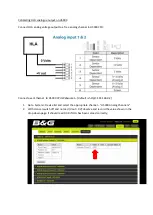
11-3
IM DL850E-01EN
Power Spectrum (PS (S1))
Performs an FFT (fast Fourier transform) on the waveform assigned to Source, and displays a power spectrum.
You can use this function to view the frequency distribution of an input signal.
Computation Source Waveform (Source), Unit (Unit), Label (Label), and Turning the Display On and Off
(Display)
These settings are the same as those for basic arithmetic.
FFT Settings (FFT Setup)
Select the data points and window function to use for the FFT.
• Number of FFT Points (FFT Points)
You can set the number of points from the start of computation on the T-Y waveform to one of the options
below.
1k, 2k, 5k, 10k, 20k, 50k, or 100k
• Window Function (Window)
You can select the window function from the following options.
Rect, Hanning, Flat Top, Hamming
Phase Shift (Shift (S1))
You can shift the phase of the waveform assigned to Source, display the resulting waveform, and use the phase-
shifted data in computations.
Computation Source Waveform (Source), Unit (Unit), Label (Label), and Turning the Display On and Off
(Display)
These settings are the same as those for basic arithmetic.
Shift (Shift)
You can shift waveforms within the following ranges.
• When an Internal Clock Is Being Used as the Time Base
Selectable range: The time values between −(record length/2) points to (record length/2 points)
Step: 1 ÷ sample rate
The sample rate varies depending on how the record length and Time/div settings are configured. For details,
see appendix 1, “Relationship between the Time Axis Setting, Record Length, and Sample Rate” in the
Getting Started Guide
, IM DL850E-03EN.
• When an External Clock Is Being Used as the Time Base
Selectable range: −(record length/2) points to (record length/2 points)
Step: 1
11 Computation
















































